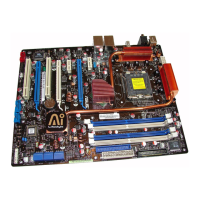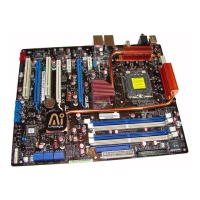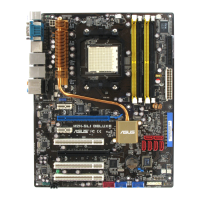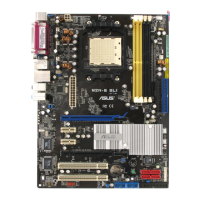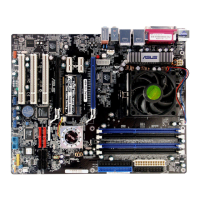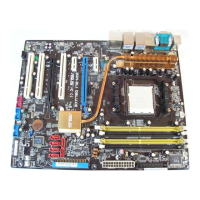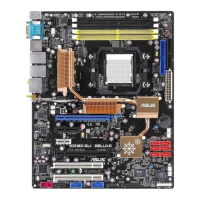Do you have a question about the Asus P5N-E SLI and is the answer not in the manual?
Lists the items included in the motherboard package.
Details the unique features and technologies of the motherboard.
Highlights key product specifications and benefits of the motherboard.
Lists precautions before installing motherboard components or changing settings.
Provides an overview of the motherboard's physical layout and installation.
Illustrates the physical placement of components and connectors on the motherboard.
Covers CPU installation, heatsink, and fan assembly procedures.
Step-by-step guide on how to install the CPU onto the motherboard socket.
Instructions for mounting the CPU heatsink and fan assembly for optimal thermal performance.
Details the system memory (DIMM) sockets and configuration options.
Explains how to configure memory modules for dual-channel operation and compatibility.
Describes PCI and PCI Express slots and their supported expansion cards.
Details the configuration options for using two PCI Express x16 slots for graphics cards.
Explains the function and configuration of motherboard jumpers, like CLRTC.
Describes the various rear panel and internal connectors on the motherboard.
Covers utilities and procedures for managing and updating the motherboard's BIOS.
Provides instructions on how to update the BIOS using the AwardBIOS Flash Utility.
Explains how to update the BIOS using the built-in EZ Flash 2 utility.
Introduces the BIOS setup program, menu navigation, and screen elements.
Displays the main BIOS setup screen layout and navigation keys.
Describes the main menu items available in the BIOS setup program.
Provides an overview of basic system information displayed in the BIOS Main menu.
Details how to configure primary and secondary IDE devices in the BIOS.
Covers advanced system settings for CPU, chipset, and onboard devices.
Explains CPU overclocking options, AI Tuning, and related settings.
Details CPU-specific settings like multiplier, core unlock, and thermal control.
Covers ACPI and APM settings for power management and system suspend.
Explains APM configuration options like power loss restore and device wake-up.
Allows changing system boot options, device priority, and boot settings.
Sets the sequence of devices from which the system attempts to boot.
Provides access to special BIOS functions like ASUS O.C. Profile and EZ Flash 2.
Allows storing and loading multiple BIOS settings and profiles.
Options for saving changes, loading defaults, or discarding settings before exiting BIOS.
Guidance on installing supported operating systems for optimal hardware performance.
Details the contents of the motherboard support CD, including drivers and utilities.
Instructions on how to launch the support CD's interface and install software.
Lists and describes essential device drivers to activate motherboard hardware.
Lists and describes applications and utilities for system monitoring and management.
Explains how to set up and use two graphics cards for enhanced performance.
Outlines the prerequisites for implementing NVIDIA SLI technology, including hardware and software.
Step-by-step guide to configuring the ASUS EZ selector card for dual graphics setups.
Instructions for creating a RAID driver disk required for OS installation on RAID arrays.
Explains the Intel Extended Memory 64 Technology (EM64T) feature for 64-bit computing.
Details the Enhanced Intel SpeedStep Technology for dynamic CPU frequency and voltage adjustment.
Lists the system requirements needed to utilize the EIST feature for power management.
Describes the Intel Hyper-Threading Technology for improved multitasking performance.
| Non-ECC | Yes |
|---|---|
| Number of memory slots | 4 |
| Maximum internal memory | 8 GB |
| Processor socket | LGA 775 (Socket T) |
| Processor manufacturer | Intel |
| USB 2.0 connectors | 2 |
| USB 2.0 ports quantity | USB 2.0 ports have a data transmission speed of 480 Mbps, and are backwards compatible with USB 1.1 ports. You can connect all kinds of peripheral devices to them. |
| Parallel ports quantity | 1 |
| Audio output channels | 6.1 channels |
| Motherboard form factor | ATX |
| LAN controller | Marvell 88E1116 |
| RAID levels | 0, 1 |




